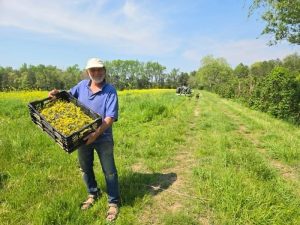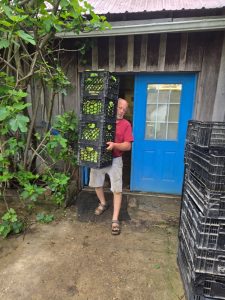The harsh reality of farming with Lyme disease

By Meg Muckenhoupt
Anyone who goes outside can catch Lyme disease from a tick bite, but some farmers have to spend their entire working day around tick habitat to do their job. That work puts them at high risk for Lyme disease, Lyme complications–and financial ruin.
Farmers with Lyme risk losing precious production time and harvests when they can’t rely on their bodies to do the work they’ve always done in the past.
Brett Grohsgal, owner of Even’ Star Farm in Saint Mary’s County, Maryland, has had eight bouts of Lyme disease. He’s had to cope with the effects of Lyme on his own work and on his farming business.
Tick habitat
Although Grohsgal works to reduce tick habitat on his farm, he can’t eliminate it. Keeping soil bare to discourage ticks isn’t possible.
“I mow aggressively, but we’re a certified organic farm. I need my cover crops, it’s not optional, so there is shelter for many, many ticks.”
Grohsgal also makes sure every farm dog and cat gets topical anti-tick treatment every month–but humans can’t get those treatments. They face Lyme risks every single day.
Daily tick checks are mandatory for Grohsgal. “I don’t know how farmers who are solo operators and don’t have someone do a tick check function. Who’s going to look at your scalp, your back?” Grohsgal said.
Farmers who contract Lyme disease tend to neglect their symptoms. “We’re macho beasts,” said Grohsgal, who typically works 90 hours a week during the summer growing season.
“But we can’t afford wear and tear on crucial machines, and Lyme affects our human machine, our body. It’s like running an engine with no oil.”
Getting weaker
During his first Lyme infection more than a decade ago, one of Grohsgal’s first symptoms was that he could no longer lift 100-lb sacks of feed for his farm’s livestock. “Lyme disease made me physically weaker,” Grohsgal said.
“I’ve always worked with my crew, but I’m not as physically strong as I was. That increases payroll costs. You need more strong workers if you take one of them out due to Lyme disease.”
Lyme doesn’t just affect a farmer’s strength. Even light farm work can become impossible thanks to Lyme-induced pain. When his most recent bout of Lyme began, Grohsgal realized he was infected when he couldn’t make a fist or hold scissors to cut arugula.
“I could not harvest as efficiently as usual because of the pain. I should have paid attention much earlier,” Grohsgal said.
Other tick-borne diseases, too
Farmers are at risk for other tick-borne diseases too, like Rocky Mountain spotted fever, babesiosis, and ehrlichiosis.
“I got diagnosed with ehrlichiosis after alpha-gal,” wrote Susan Beattie Barrett, who works on her family’s farm in Missouri.
“I was very sick. I struggled with being very tired, got confused right before diagnosis. I just couldn’t focus. I had a really bad weekend where I felt as if I was dying, went to the doctor on Monday for more tick testing and was diagnosed with ehrlichiosis and was on antibiotics for two months…. I would probably move to the city if we didn’t farm, as I feel like living in the country I am at higher risk.”
Meanwhile, Grohsgal isn’t sure how much longer he can work on his farm. “I was planning to retire at 70,” said Grohsgal, who is now 65.
“I don’t think my body can take farming more than two more years. I work 90 hours a week every summer, and 75 hours a week in the winter. Lyme has made those hours painful, and when you are in pain, you’re not as good a worker.”
Meg Muckenhoupt works with Alpha-gal Information, an Alpha-gal Alliance project.






















We invite you to comment on our Facebook page.
Visit LymeDisease.org Facebook Page